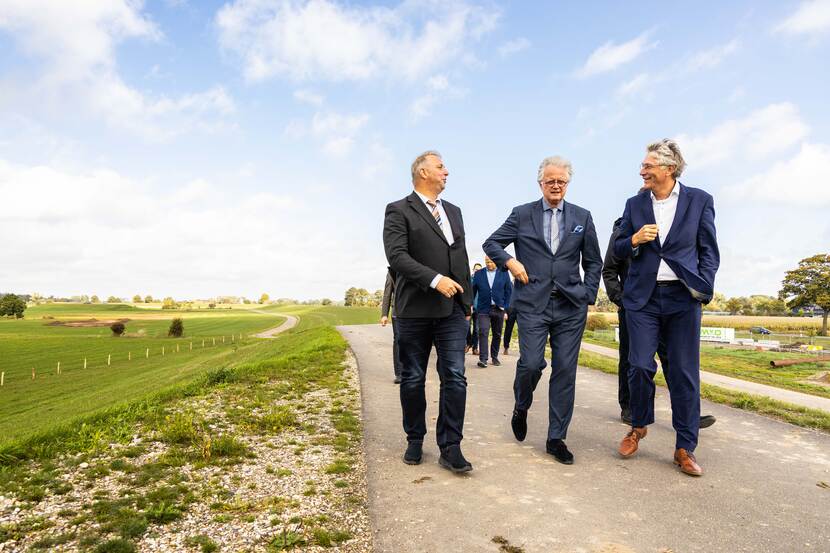Delta Programme Commissioner Peter Glas on field trip to border region
On Friday, 27 September the Delta Programme Commissioner paid a working visit to the Rhine border area. The visit was focused on flood protection and flood risk management in the border region. He toured two projects: the dykes crossing the German border, and the Rijnstrangen area near the city of Zevenaar.

On the Halsaf country estate, the Delta Programme Commissioner was welcomed by Hein Pieper, Chairman of the Rijn en IJssel district water board. Also in attendance were officials such as Rijkswaterstaat Chief Engineer-Director Nelly Kals, member of the Gelderland provincial executive Peter van ’t Hoog, and dyke reeve Frank Wissink of the Rijn en IJssel district water board.
In the morning the party visited two trans-border dyke rings. The Delta Programme Commissioner met with representatives of water management bodies on both the German and Dutch sides of the border to discuss how they are dealing with different cultures, policy differences, different standards, differences in dyke construction, and differences in the points of departure observed. Considering that the eastern part of the Netherlands is dependent on the strength of the German dykes, collaboration is vitally important.
Subsequently, the party went on to the newly completed dyke between Praest and Bienen, and to a farm that had recently been demolished in the purview of the forthcoming dyke improvement at this spot. During the trip, those present underscored the good German-Dutch collaboration. Administrators of the Düsseldorf Bezirksregierung and the Deichverband Bislich-Landesgrenze reported on the dyke improvement programme under way on the German side of the border, and on the methods being employed to improve the dykes in Germany.

Chairman Hein Pieper explained: ‘Dykes do not stop at the border and neither does water. What started out as a mandatory collaboration under trans-border management now involves collaborative efforts covering a much wider scope, such as flood protection, disaster drills, water quality, coypus, and coping with extreme weather. It is imperative that we continue to operate from the region, unhampered by national borders.’
The afternoon part of the programme was devoted to the Rijnstrangen area. This area has been earmarked as a potential long-term water storage zone, for the period beyond 2050. The party visited the region, which is renowned for its characteristic old, steep dykes. The Delta Programme Commissioner met with the Mayor and Alderman of Zevenaar, and with delegates of regional village councils. All reiterated the importance of efficient information provision to the area. The Alderman: ‘We report what we know, but also what we do not know.’ Delta Programme Commissioner Peter Glas expressed his appreciation of the manner in which the village councils have initiated a dialogue with the municipal authorities: ‘I applaud the way in which the municipalities are looking after the interests of their residents here.’
The field trip was rounded off by a visit to the Pannerdense Overlaat distribution structure. The Rijkswaterstaat delegate explained how the discharge is distributed, and how the distribution structures are operating to that end.
Delta Programme Commissioner Peter Glas concluded: ‘Today, I witnessed how a national tasking extends to individual gardens. This is where the work must be carried out. I believe that in this region, the parties are extremely efficient in engaging in concerted action.’